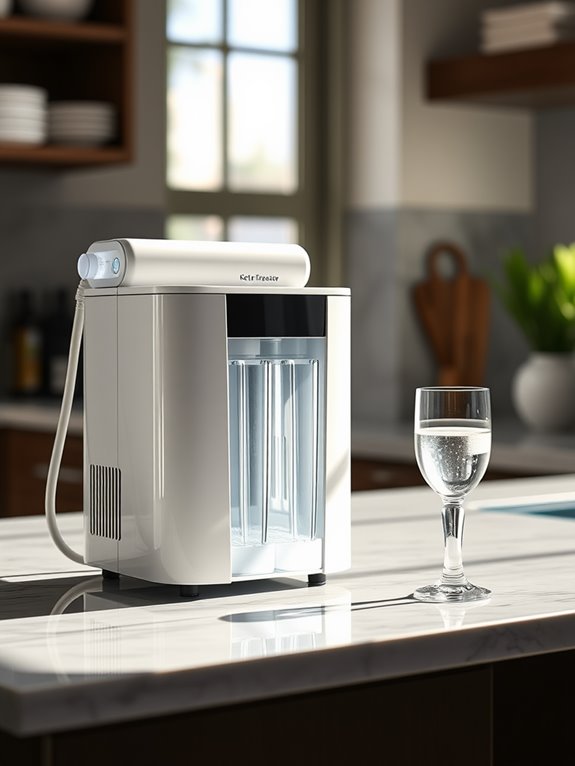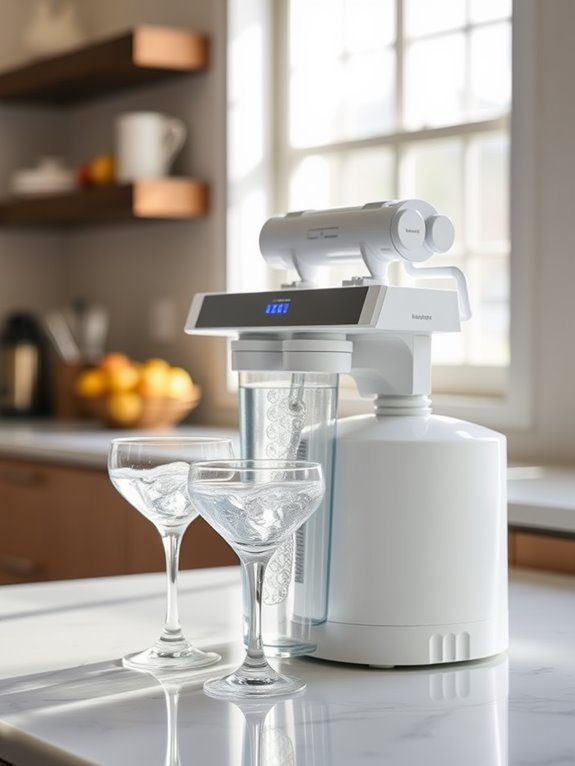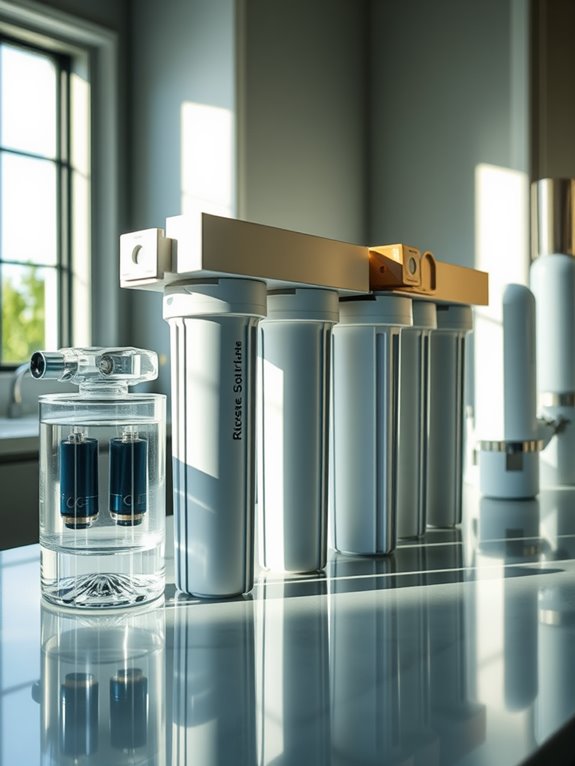When searching for the best reverse osmosis systems for pure drinking water, look for models with multiple filtration stages that effectively remove contaminants like heavy metals and bacteria. Consider efficiency, ease of installation, and ongoing maintenance. High-quality systems produce great-tasting water while reducing reliance on bottled options. You’ll want to check features like filter replacement availability and wastewater ratios as these can impact overall value. Discover more about top systems and their benefits for your health and home.
Understanding Reverse Osmosis Technology

Reverse osmosis (RO) is a powerful filtration technology that’s widely used to purify drinking water.
It works by pushing water through a semi-permeable membrane, which effectively removes contaminants, including salts, bacteria, and other impurities.
As the water passes through, only pure molecules can filter through the tiny pores, leaving behind harmful substances.
You’ll appreciate how efficient this process is, as it produces clean, great-tasting water while conserving resources.
RO systems can considerably improve your water quality, making it safe for drinking and cooking.
Key Features to Look for in a Reverse Osmosis System
When choosing a reverse osmosis system, you should consider the filtration stages and overall efficiency.
These factors play an essential role in guaranteeing you get clean, safe drinking water.
Additionally, check the availability of replacement filters to make certain your system remains effective over time.
Filtration Stages and Efficiency
Understanding the filtration stages in a reverse osmosis system is vital for guaranteeing you get clean, safe drinking water. Each stage plays a significant role in removing contaminants effectively.
- Pre-filtration: Removes larger particles and sediments.
- Reverse Osmosis membrane: Eliminates dissolved solids, heavy metals, and chemicals.
- Post-filtration: Polishes the water for taste and odor.
A system with multiple filtration stages guarantees higher efficiency and better water quality.
Pay attention to the number and types of filters used, as they directly impact the system’s overall performance.
Prioritize systems that deliver maximum purification with minimal waste.
Replacement Filter Availability
After guaranteeing your reverse osmosis system effectively filters contaminants, it’s important to contemplate how easily you can replace the filters.
Look for systems with readily available replacement filters, either online or at local stores. Check if the manufacturer provides a subscription service for regular filter delivery, making maintenance hassle-free.
Consider the type of filters required; some systems use universal filters, while others may need proprietary ones, which could be harder to find.
Additionally, verify how often filters need replacing to avoid unexpected costs. A system with accessible filters guarantees you maintain peak performance without unnecessary stress.
There’s more to explore! Here’s another valuable read: Are Hot Water Systems Electric? Exploring Different Water Heating Methods
Top Reverse Osmosis Systems Reviewed

Now that you know what features to look for in a reverse osmosis system, let’s compare some top models.
You’ll want to evaluate their overall performance, how easy they’re to install and maintain, and what kind of value they offer for the price.
This will help you make an informed decision for your drinking water needs.
System Performance Comparison
How do you choose the best reverse osmosis system for your drinking water needs?
You’ll want to compare performance across several key factors to guarantee you make the right choice.
- Filtration efficiency: How well does the system remove contaminants?
- Water production rate: How much purified water can you expect daily?
- Wastewater ratio: How efficiently does the system use water?
Installation and Maintenance
Evaluating the performance of reverse osmosis systems sets a solid foundation for understanding their installation and maintenance needs. Proper installation guarantees peak functionality, while regular maintenance prolongs the lifespan of your system. You should follow guidelines specific to your model, but here’s a quick overview:
| Task | Frequency |
|---|---|
| Filter Replacement | Every 6-12 months |
| Membrane Replacement | Every 2-3 years |
| System Sanitization | Annually |
| Check Water Quality | Quarterly |
| Inspect Hoses/Connections | Biannually |
With these tips, you’ll enjoy pure drinking water efficiently!
Cost and Value Analysis
When you’re considering a reverse osmosis system for your home, understanding the cost and value can greatly impact your decision.
You’ll want to evaluate not just the initial price but also the long-term benefits.
- Assess the cost of replacement filters and membranes.
- Factor in the energy consumption of the system.
- Consider the quality of water produced and its health benefits.
There’s more to explore! Here’s another valuable read: Are Water Filtration Systems Necessary? Benefits and Considerations
Installation and Maintenance of Reverse Osmosis Systems
Although installing and maintaining a reverse osmosis system might seem intimidating, it’s quite manageable with the right guidance.
Start by selecting an appropriate location under your sink. Follow the manufacturer’s instructions to connect the system to your water supply, ensuring all fittings are tight to prevent leaks.
Regular maintenance involves changing filters and membranes as recommended—typically every six months to two years. Keep an eye on water quality and pressure; if you notice a drop, it might be time for a filter change.
With a little diligence, you’ll enjoy pure drinking water without hassle!
Here’s another post you might find useful: How Does a Water Treatment Plant Work? Step-by-Step Process
Comparing Cost and Performance of Popular Models

After you’ve got your reverse osmosis system installed and maintained properly, it’s time to contemplate which model best fits your needs.
You’ll want to weigh the cost against performance to guarantee you’re making a smart choice.
- Look at initial purchase prices and long-term maintenance costs.
- Evaluate the filtration capacity and speed of each model.
- Consider the warranty and customer support options available.
Benefits of Using a Reverse Osmosis System for Drinking Water
One of the key benefits of using a reverse osmosis system for drinking water is its ability to remove a wide range of contaminants, providing you with cleaner, safer water. You’ll enjoy better taste and odor, which can enhance your drinking experience. Additionally, it can reduce your reliance on bottled water, saving you money and reducing plastic waste.
| Contaminant Removed | Benefit |
|---|---|
| Lead | Protects your health |
| Chlorine | Improves taste |
| Fluoride | Reduces dental concerns |
| Pesticides | Guarantees safer water |
Invest in your health today!
Conclusion
To sum up, investing in a reverse osmosis system isn’t just a choice; it’s a life-altering decision for your health and hydration! Imagine drinking the purest water on the planet, free from impurities and contaminants. With the right system, you’re not just quenching your thirst; you’re elevating your entire lifestyle! Don’t settle for mediocre tap water when you can have liquid gold flowing straight from your kitchen. Choose the best, and your taste buds—along with your family—will thank you!

I’m Allen Kim, the chief editor of plumbinginto. I am a mid level plumber and assign to an local firm over 4 years of experience. During the working period, most of my experience is related to the house plumbing. I learned about the thing, when working with most experienced people in this sector, one must be as good as the inspector or better with knowledge of the project as well as the practical aspects of plumbing industry.